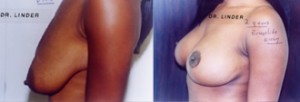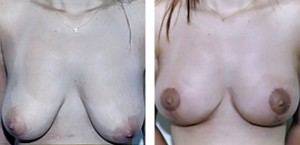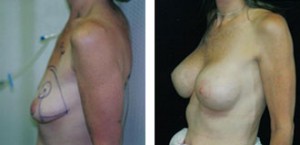Beverly Hills Breast Lift
Posted On: February 17, 2009 Author: The Office of Dr. Stuart Linder Posted In: Home
Patients come from all over the world to undergo breast augmentation, breast lift and breast reduction surgery. The appropriate breast lift must be performed for each patient and individualized in order to obtain an excellent and acceptable result.
 First of all, all forms of breast lifts are associated with some risk in the form of scarring. Scarring can at no time be absolutely guaranteed from any doctor at any time on any given patient, regardless of previous history of scarring. Scarring can be associated with multiple problems including thickening of the scars, often referred to as hypertrophic scarring or even keloiding where the scar overgrows its own borders. Scarring can also be associated with spreading referred to as wide spreading of the scar where the scar seems to be very wide and somewhat irregular and variegated in pattern. Scars can be colored or discolored, hyperpigmented or hypopigmented as well. In fact, scars can have a combination of the above variations with discoloration as well as thickening and/or spreading. Therefore, the patient must be informed that there is significant risk of scarring and that the final absolute predictability of the scar can never be guaranteed. It simply is a risk that the patient will have to take. If the scarring risk is not worth the tightening of the breast, or reduction of the size of the breast, then the patient is not an appropriate candidate either mentally or physically for the operation.
First of all, all forms of breast lifts are associated with some risk in the form of scarring. Scarring can at no time be absolutely guaranteed from any doctor at any time on any given patient, regardless of previous history of scarring. Scarring can be associated with multiple problems including thickening of the scars, often referred to as hypertrophic scarring or even keloiding where the scar overgrows its own borders. Scarring can also be associated with spreading referred to as wide spreading of the scar where the scar seems to be very wide and somewhat irregular and variegated in pattern. Scars can be colored or discolored, hyperpigmented or hypopigmented as well. In fact, scars can have a combination of the above variations with discoloration as well as thickening and/or spreading. Therefore, the patient must be informed that there is significant risk of scarring and that the final absolute predictability of the scar can never be guaranteed. It simply is a risk that the patient will have to take. If the scarring risk is not worth the tightening of the breast, or reduction of the size of the breast, then the patient is not an appropriate candidate either mentally or physically for the operation.
 There are several types of breast lifts that are performed. The first is a small periareolar crescent lift. This is only useful for very small amounts of lifting of the areola. A periareolar lift in itself realistically cannot elevate the entire breast. This is an operation that normally requires more skin removed either vertically and/or along the inframammary fold. Periareolar lifts can be combined with implants placed subpectorally for mild or grade 1 ptosis. However, when there is skin laxity in which the nipple is either at or below the inframammary fold, it often will require some form of vertical mastopexy or a formal mastopexy referred to as the anchor scar with an incision around the nipple areolar complex vertically down the midline along the inframammary fold.
There are several types of breast lifts that are performed. The first is a small periareolar crescent lift. This is only useful for very small amounts of lifting of the areola. A periareolar lift in itself realistically cannot elevate the entire breast. This is an operation that normally requires more skin removed either vertically and/or along the inframammary fold. Periareolar lifts can be combined with implants placed subpectorally for mild or grade 1 ptosis. However, when there is skin laxity in which the nipple is either at or below the inframammary fold, it often will require some form of vertical mastopexy or a formal mastopexy referred to as the anchor scar with an incision around the nipple areolar complex vertically down the midline along the inframammary fold.
 Patients with moderate amount of skin laxity often referred to as grade 2 ptosis, may often proceed with implants and a vertical lift also referred to as a lollipop scar. These patients may achieve an excellent result without the necessary inframammary scar along the fold. However, when a patient has what is referred to as grade 3 ptosis, the nipple-areolar complex is well below 3 cm, below the inframammary fold. Normally a complete formal mastopexy with the anchor scar or Wise-pattern technique is required. If the appropriate lift is not done with patients with severe skin laxity, then the shape of the breast can be disfigured. We see this often in our Beverly Hills practice and fixing it may only require performing a revision of the lift and often adding excision of skin vertically as well as along the inframammary fold.
Patients with moderate amount of skin laxity often referred to as grade 2 ptosis, may often proceed with implants and a vertical lift also referred to as a lollipop scar. These patients may achieve an excellent result without the necessary inframammary scar along the fold. However, when a patient has what is referred to as grade 3 ptosis, the nipple-areolar complex is well below 3 cm, below the inframammary fold. Normally a complete formal mastopexy with the anchor scar or Wise-pattern technique is required. If the appropriate lift is not done with patients with severe skin laxity, then the shape of the breast can be disfigured. We see this often in our Beverly Hills practice and fixing it may only require performing a revision of the lift and often adding excision of skin vertically as well as along the inframammary fold.
Recently, I had a patient that I operated on who had a round-block technique lift where the skin was removed circumferentially around the areola and she flew in to have this revised. The breast revision simply required removing the excess skin which had not been done in the first surgery through an appropriate and proper formal mastopexy removing skin again circumferentially around the areola, down the middle and along the inframammary fold. This now gave her appropriate shape to her breasts and I was able to remove all the redundant widespread scarring around the nipple areolar complex which was now approximately 10 cm in diameter reduced to 4.2 cm on this operation.
It is very simple to remember two things: one, scarring is inevitable with breast lift surgery. You will have to accept the scarring regardless of what the outcome. We can do our best to make the scars as beautiful as possible; however the body plays a large role into the final outcome. Secondly, there are postoperative modalities including different types of creams, scar treatments as well as laser therapy and silicone gel sheeting and sprays which may be useful; and lastly, the appropriate breast lift must be performed on each specific patient’s needs. If the doctor is trying to be somewhat conservative and performs the wrong surgery, it is very highly likely that the patient will be back to another surgeon’s office for correction.